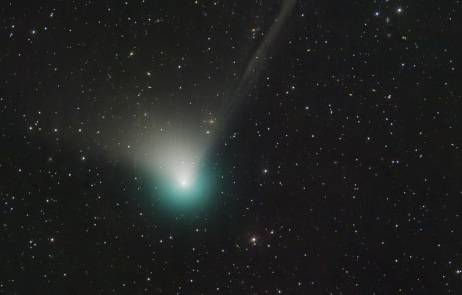It’s prime time to see the comet known as C/2022 E3, marked by its bright green nucleus and long faint ion tail. It’s visible now with telescopes and binoculars, and the best chance of seeing it with the naked eye is coming up in early February.
This marks possibly the first time ever — or at least for thousands of years — that the comet has streaked across the Earth sky.
“If C/2022 E3 has ever passed through the solar system before, it would have last been seen in the sky more than 10,000 years ago,” Jon Giorgini, a senior analyst at NASA’s Jet Propulsion Laboratory, told NPR.
Astronomers first spotted the brightening outburst in March 2022 at the Zwicky Transient Facility on Palomar Mountain in California. At the time, the comet was inside the orbit of Jupiter.
The best chance to see the comet is between Feb. 1 and Feb. 2
For the past week and a half, the comet has been moving closer to Earth and as a result, becoming more visible in the Earth sky.
Between Feb. 1 and Feb. 2, the newly discovered comet is slated to draw nearest to Earth — 26.4 million miles away to be exact — meaning it will be the best chance to see its glow unaided.
Comets are essentially clumps of frozen gases, rock and dust. But when they approach the sun and heat up, they become powerful cosmic objects, spewing gases and dust in a way that forms their iconic shape: a glowing core and flame-like tail that can stretch on for millions of miles.
The brightness of comets tends to be unpredictable, but this one’s current behavior is promising, according to a recent explainer from Preston Dyches of NASA’s Jet Propulsion Laboratory.
Its glow may be visible to the naked eye in dark night skies, he said, while observers with binoculars or telescopes have a greater chance of witnessing the rare speck of light.
Spectators in the Northern Hemisphere can begin to spot the comet’s faint glow in the morning sky, as it journeys toward the northwest, according to Dyches. The comet will likely be visible to those in the Southern Hemisphere starting early February.
After its brief appearance in the Earth skies, it’s unclear where it may go.
Because scientists have only recently begun to track the comet’s path, there is still a lot to understand about C/2022 E3, says Giorgini.
It’s possible it may gain enough energy to fling out of our solar system, or it might remain bound to its elliptical orbit for another trip around the sun.
